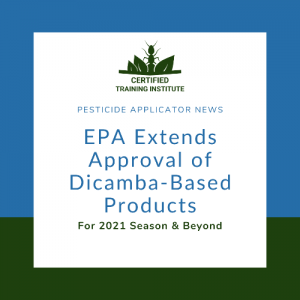EPA Extends Approval of Dicamba-Based Products for 2021 Season & Beyond
Published on November 5, 2020 by Nate Bortz

Just last week, the US Environmental Protection Agency (EPA) decided to approve new five-year registrations for two “over-the-top” (OTT) dicamba products—XtendiMax with VaporGrip Technology and Engenia Herbicide—and extended the registration for an additional OTT dicamba product, Tavium Plus VaporGrip Technology. The extended registrations are only for use on dicamba-tolerant (DT) cotton and soybeans and will expire in 2025.
The decision is not free from controversy, however.
Background
In a previous blog, we outlined the bumpy road dicamba has experienced over the past few years – culminating in June 2020 when the U.S. Ninth Circuit Court of Appeals blocked registrations for three major dicamba brands. The court’s decision was largely based on accounts of dicamba-based products drifting into nearby fields after application and destroying non-DT crops.
Despite the Circuit Court’s ruling, EPA Administrator Andrew Wheeler defended the decision.”After reviewing substantial amounts of new information, conducting scientific assessments based on the best available science, and carefully considering input from stakeholders, we have reached a resolution that is good for our farmers and our environment,” Wheeler said.
Organizations like the American Farm Bureau, Georgia Cotton Commission, and weed scientists in the University of Georgia Extension praised the EPA’s decision mainly for “providing clarity” to farmers for the 2021 growing season and beyond.
Dicamba critics see the decision differently, with The Center for Food Safety, Center for Biological Diversity, National Family Farm Coalition, and Pesticide Action Network North America planning to pursue a legal challenge.
What the Decision Means for Applicators
The EPA’s 2020 registration features important control measures to manage off-site movement of dicamba, including:
- Requiring an approved pH-buffering agent (also called a Volatility Reduction Agent or VRA) be tank mixed with OTT dicamba products prior to all applications to control volatility.
- Requiring a downwind buffer of 240 feet and 310 feet in areas where listed species are located.
- Prohibiting OTT application of dicamba on soybeans after June 30 and cotton after July 30.
- Simplifying the label and use directions so that growers can more easily determine when and how to properly apply dicamba.
The EPA claims these control measures provide new flexibilities for growers and also address the concerns expressed in regard to the June Court of Appeals ruling.
What are your thoughts on the new dicamba control measures? Let us know on social media!
